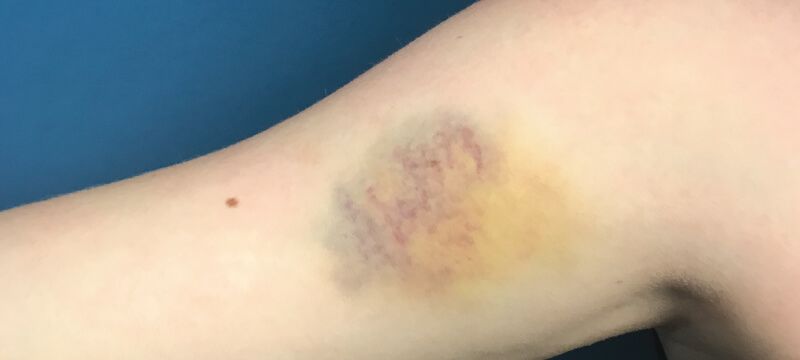Ask A Dermatologist: How To Get Rid Of Bruises

Bruising is the skin’s natural way for dealing with a contusion. Bruises occur as blood released from broke capillaries pools under the skin. Over time this pooled blood drains away and the soreness and discoloration of the skin disappears. While bruises are rarely causes for concern; bruises that occur in a visible area can sometimes be embarrassing.
Even though bruising heals on its own there are some things you can do to speed up the healing process.
Using cold and warm compresses
The best way to limit the visual severity of a bruise is to apply cold to the bruise as soon as possible. Over the course of the first day alternate applying an ice pack to the bruise in 15 minute intervals. The immediate and consistent application of cold to the bruised area reduces the swelling of tissue as well as the amount of pooled blood under this skin, thus minimizing the visual extent of the bruise.
After about 48 hours the bruise will begin to heal. At this point in time applying a warm compress will increase circulation within the bruised area; speeding up the healing process.
Additional treatment techniques
While the application of heat and cold is the best way to accelerate bruise healing, there are a few other ways that can help to expedite the healing process:
- Elevation: If possible, try to keep the bruised area elevated; which will help to carry excess blood away from the contusion; minimizing pooling. If the bruised area is on the legs or hips simply lying down or sitting in a reclining position will work.
- Compression: Using a compression garment or wrapping a bandage around the area can also improve circulation.
- Eat a balanced diet: A healthy diet can both prevent bruising and speed up the skin’s natural healing process. If you find that you bruise easily and often you may have a deficiency in vitamins C, K, B12, or B9. Add foods high in these vitamins to your diet or look for dietary supplements containing them.
- Vitamin K cream: Topical creams that contain vitamin K have been clinically proven to speed up the healing of bruises. Studies also suggest the herb Arnica Montana can help as well.
- Aspirin: Both ibuprofen and acetaminophen work really well to reduce pain associated with bruising. However, if you regularly take NSAIDs be aware that they can reduce blot clotting and thus encourage bruising of the skin.
